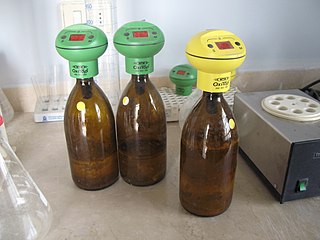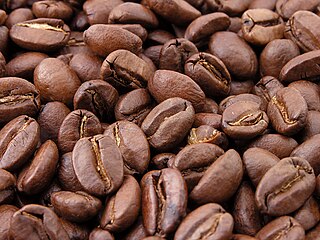Water usage
The amount of water used in processing depends strongly on the type of processing. Wet fully washed processing of the coffee cherries requires the most fresh water, dry processing the least. Sources indicate a wide range in water use.[ citation needed ] Recycling of water in the de-pulping process can drastically reduce the amount needed. With reuse and improved washing techniques, up to 1 to 6 m³ water per tonne of fresh coffee cherry is achievable; without reuse a consumption of up to 20 m³/tonne is possible.
| Country | Process | Water use m³/tonne cherry | Source |
|---|---|---|---|
| India | Semi-washed, wet processing | 3 | [7] |
| Kenya | Fully washed, reuse of water | 4-6 | [8] |
| Colombia | Fully washed and environmental processing (BECOLSUB) | 1-6 | [8] |
| Papua New Guinea | Fully washed, recycling use of water | 4-8 | [8] |
| Vietnam | Semi wet and fully washed | 4-15 | [8] |
| Vietnam | Traditional, fully washed | 20 | [9] |
| India | Traditional, fully washed | 14-17 | [10] |
| Brazil | Semi-washed, mechanical demucilage | 4 | [11] |
| Mexico | Semi-washed, mechanical demucilage | 3.4 | [12] |
| Nicaragua | Traditional, fully washed | 16 | [13] |
| Nicaragua | Fully washed, reuse of water | 11 | [14] |
General

Water used in processing coffee leaves the coffee processing unit with high levels of pollution. The main component is organic matter, stemming from de-pulping and mucilage removal. [15] The majority of organic material in the wastewater is highly resistant and COD values, the amount oxygen required to stabilize organic matter by using a strong oxidant, make up 80% of the pollution load, with values as high as 50 g/L. [16] [17] The BOD, the amount of oxygen required for the biological decomposition of organic matter under aerobic conditions at a standardized temperature and time of incubation, [18] coming from biodegradable organic material can reach values of 20 g/L.
With a (rough) screening and removal of the pulp COD and BOD values become considerably lower. Values in the range of 3 - 5 g/L for COD and 1.5– 3 g/L for BOD5 [note 2] were found. [11] Recorded values of 2.5 g/L for COD and 1.5 g/L for BOD5. [19] [20]
A large part of the organic matter, pectins, precipitates as mucilated solids and could be taken out of the water. [16] When these solids are not removed and pH values rise and an increase in COD can be observed.
In order to optimize the anaerobic processing of the wastewater pH values should be between 6.5 and 7.5, instead of the generally present values of pH=4, which is highly acidic. This is obtained by adding calcium hydroxide (CaOH2) to the wastewater. This resulted in a regained solubility of the pectins, raising COD from an average of 3.7 g/L to an average of 12.7 g/L.
The water is further characterised by the presence of flavonoid compounds, coming from the skin of the cherries. Flavonoid compounds result in dark colouration of the water at a pH=7 or higher, but they do not add to BOD or COD levels of the wastewater, nor have major environmental impacts. Lower levels of transparency, however, can have a negative impact on photosynthetic processes and growth and nutrient transformations by (especially) rooted water plants. Many efforts in olive and wine processing industries, with relatively large funds for research, have been trying to find a solution for this problem. Calvert mentions research done into the removal of polyphenolics and flavonoid compounds by species of wood digesting fungi (Basidiomycetes) in a submerged solution with aeration using compressed air. [21] These complex processes seemed to be able to remove the colour compounds, but simplified, cheaper techniques using other types of fungi (i.e. Geotrichum , Penicillium , Aspergillus ) only thrived in highly diluted wastewaters.
Coffee wastewater is not a constant flow of water with uniform loadings of contamination. The processing of coffee cherries is a batch process and regarding water flows, two processes can be determined: de-pulping and fermentation/washing.
De-pulping

The water used for de-pulping of the cherries is referred to as pulping water. It accounts for just over half of the water used in the process. According to Von Enden and Calvert, "pulping water consists of quickly fermenting sugars from both pulp and mucilage components. Pulp and mucilage consists to a large extent of proteins, sugars and the mucilage in particular of pectins, i.e. polysaccharide carbohydrates. [15] These sugars are fermenting using the enzymes from the bacteria on the cherries. Other components in pulping water are acids and toxic chemicals like polyphenolics (tannins) or alkaloids (caffeine).
Pulping water can be reused during the de-pulping of the harvest of one day. This results in an increase in organic matter and a decrease in pH. Research in Nicaragua showed COD averages rising from 5,400 mg/L up to 8,400 mg/L with most of the pulp removed. [14] The drop in pH can be attributed to the start of fermentation of the pulping water. This drop continues until fermentation is finished and pH levels of around 4 are reached. The nutrient content of the pulping water at the maximum COD load, which was considered to reflect maximum pollution, was determined during this research. Total nitrogen (TN) concentration in the samples ranged from 50 to 110 mg/L with an average over all samples of 90 mg/L. Total phosphorus (TP) concentration in the samples ranged from 8.9 to 15.2 mg/L with an average over all samples of 12.4 mg/L.
Washing
Washing of the fermented beans leads to wastewater containing mainly pectins from the mucilage, proteins and sugars. The fermentation of the sugars (disaccharide carbohydrates) into ethanol and CO2 leads to acid conditions in the washing water. The ethanol is converted in acetic acids after reaction with oxygen, lowering the pH to levels of around 4. The high acidity can negatively affect the treatment efficiency of treatment facilities treating the coffee wastewater like an anaerobic reactor or constructed wetlands and is considered to be detrimental for aquatic life when discharged directly into surface waters.
During the washing process the research in Nicaragua showed a clear decrease in contamination of the wastewater. [14] The COD values drop from an average of 7,200 mg/L to less than 50 mg/L. Despite the fact that wastewater with COD values below 200 mg/L is allowed to be discharged in the natural waterways in Nicaragua it is advisable to redirect all the wastewater to the treatment system. This is because COD levels cannot be determined onsite during the washing process and discharge of the wastewater into surface waters is based on visual inspection. When the water is "clear" it is considered to be clean enough but the COD values measured during the research showed that discharge generally was to soon, resulting in wastewater with higher levels of COD than permitted. Another positive effect of diverting the wastewater to a treatment system is the dilution of the wastewater which enables better treatment by anaerobic bacteria due to more favourable pH values and better post-treatment due to lower concentrations of ammonium.
TN concentration in the samples of wastewater stemming from washing ranged from 40 to 150 mg/L with an average over all samples of 110 mg/L. TP concentration in the samples ranged from 7.8 to 15.8 mg/L with an average over all samples of 10.7 mg/L.














